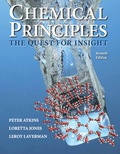
(a)
Interpretation:
The required volume of
pH definition:
The concentration of hydrogen ion is measured using
The
On rearranging, the concentration of hydrogen ion
(a)
Answer to Problem 6H.3E
The required volume of
Explanation of Solution
The amount of
The
From the above reaction stoichiometry,
Here,
Hence, the required volume of
(b)
Interpretation:
The required volume of
Concept introduction:
Refer to part (a).
(b)
Answer to Problem 6H.3E
The required volume of
Explanation of Solution
The amount of
The chemical reaction for the neutralization process is given below
From the above reaction stoichiometry,
Here,
Therefore, the required volume of
(c)
Interpretation:
The molar concentration of
Concept introduction:
Refer to part (a).
(c)
Explanation of Solution
The molar concentration of
The amount of
Existing volume of
Further addition of
Therefore, the total amount of
Hence, the amount of
The unreacted
The molar concentration of
Therefore, the concentration of
Here, base is in excess, therefore, the
Hence, the
The amount of
The
The amount of
Existing volume of
Further addition of
Therefore, the total amount of
Hence, the amount of
The unreacted
Want to see more full solutions like this?
Chapter 6 Solutions
EBK CHEMICAL PRINCIPLES
- When carbon dioxide dissolves in water it reacts to produce carbonic acid, H2CO3(aq), which can ionize in two steps. H2CO3(aq)HCO3(aq)+H+(aq)Kc1=4.2107HCO3(aq)CO32(aq)+H+(aq)Kc2=4.81011 Calculate the equilibrium constant for the reaction H2CO3(aq)CO32(aq)+2H+(aq)arrow_forwardActually, the carbon in CO2(g) is thermodynamically unstable with respect to the carbon in calcium carbonate(limestone). Verify this by determining the standardGibbs free energy change for the reaction of lime,CaO(s), with CO2(g) to make CaCO3(s).arrow_forwardit is determined through a titration experiment that the molarity of acetic acid, CH3COOH, in vinegar is 0.883 M. what is the %(w/v) of acetic acid in this vinegar sample?arrow_forward
- A brand of window-cleaning fluid is composed of ammonia solution, water, a colouring agent, and a very small quantity of soap. It has 0.15 mol/L concentration of NH3(aq). What is the pH of this fluid?arrow_forwardAdenosine triphosphate, ATP, is used to store energy within biological systems. It releases that energy by losing a terminal phosphate group, Pi, to form adenosine diphosphate, ADP, through the hydrolysis reaction ATP(aq) + H2O(I) → ADP(aq) + Pi(aq) + H+(aq) . The standard reaction Gibbs energy, ΔrGΘ, for the hydrolysis of ATP to ADP is+ 10 kJ mol-1 at 298 K.This assumes that the concentration of hydrogen ions is 1 mol dm-3 . (a) In biochemistry, it is common practice to assume an alternative , and more realistic, standard state for which pH = 7. What is the corresponding standard reaction Gibbs energy, denoted ΔrGΘ, for this biological standardstate? (b) What is the Gibbs energy of reaction in an environment at 37 °C and pH = 7 in which the ATP. ADP. and P; concentrations are all (i) 1.0 mmol dm-3, (ii) 1.0 μmol dm-3 ?arrow_forwardA constant current flows for 3.75 h through an electrolytic cell containing aqueous AgNO3(aq). During this time, 2.00 g of silver are deposited on the electrode. What is the current flowing through the cell?arrow_forward
- When sodium acetate, CH3COONa(s), is added to CH3COOH (aq), why does the pH of the solution increase?arrow_forwardA buffer solution of volume 100 cm3 consists of 0.10 M CH3COOH(aq) and 0.10 MNaCH3CO2(aq). (a) What is its pH? (b) What is the pH after the addition of 3.3 mmol NaOH to the buffer solution? (c) What is the pH after the addition of 6.0 mmol HNO3 to the initial buffer solution?arrow_forwardAssuming the base completely dissociates in water, what is the pH of a 5.70 g/L solution of Ba(OH) 2 (aq) ?arrow_forward
- How many grams of cadmium are deposited from an aqueous solution of cadmium sulfate, CdSO4, when an electric current of 1.70 A flows through the solution for 214 min?arrow_forwardA voltaic cell is constructed in which the cathode is a standard hydrogen electrode and the anode is a hydrogen electrode ()= 1atm) immersed in a solution of unknown [H+]. If the cell potential is 0.196V, what is the pH of the unknown solution at 298 K?arrow_forwardIf the equilibrium constant for A + B C is 0.180, what is the equilibrium constant for 2C 2A + 2B ?arrow_forward
 Chemistry: Principles and PracticeChemistryISBN:9780534420123Author:Daniel L. Reger, Scott R. Goode, David W. Ball, Edward MercerPublisher:Cengage Learning
Chemistry: Principles and PracticeChemistryISBN:9780534420123Author:Daniel L. Reger, Scott R. Goode, David W. Ball, Edward MercerPublisher:Cengage Learning Chemistry: The Molecular ScienceChemistryISBN:9781285199047Author:John W. Moore, Conrad L. StanitskiPublisher:Cengage Learning
Chemistry: The Molecular ScienceChemistryISBN:9781285199047Author:John W. Moore, Conrad L. StanitskiPublisher:Cengage Learning Chemistry: Principles and ReactionsChemistryISBN:9781305079373Author:William L. Masterton, Cecile N. HurleyPublisher:Cengage Learning
Chemistry: Principles and ReactionsChemistryISBN:9781305079373Author:William L. Masterton, Cecile N. HurleyPublisher:Cengage Learning


